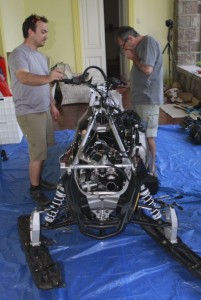UMaine Climate Change Research Team Explores Chiléan Glacier: Blog One
Click here to see all Climate Change blog entries.
Editor’s note: A team of scientists from the University of Maine’s Climate Change Institute is currently on an expedition in Chilé, traveling to the Tupungatito Glacier, located in a volcanic crater at an elevation of 19,000 feet in the Andes Mountains. This blog post is the first of a series of entries Paul Mayewski, director of the Climate Change Institute and Bjorn Grigholm, a Ph.D. student in Earth Science at UMaine, will be sending back via satellite phone from the field.

South America is in the midst of dramatic changes in water resources and is at particular risk for future abrupt climate change as a consequence of greenhouse gas warming, recovery of the Antarctic ozone hole, and increased industrialization in both hemispheres. Understanding the past and present climatic behavior of high mountain regions in South America is critical for developing appropriate mitigation and adaptation policies for water usage and for predicting future climate change. The reconstruction of past climate conditions provides essential historical context for natural climate variability (a time before human influences) that can be implemented to gauge the relative impact of human activities on the physical and chemical climate system. Ice core records provide the most robust method for reconstructing climate in the absence of instrumental records, which are very rare and of short duration in remote regions such as the Andes.

Tupungatito is a high elevation (18,909 ft, 33 degrees 25 minutes South; 69 degrees 48 minutes West) volcanic crater that is particularly well located for monitoring changes in the El Nino – Southern Oscillation, which is a major component of ocean-atmosphere circulation in the tropical Pacific and beyond; major atmospheric circulation patterns such as the easterlies and westerlies; and human- source pollutants from industrial, urban and agricultural activities in South America. A Tupungatito ice core will add to the limited collection of ice cores outside the polar regions. These low-mid latitude climate records are crucial for interpreting global climate change from the equator to the Poles. Tupungatito and surrounding Andean glaciers are also a primary source for water to major population centers, such as Santiago, Chile. Recent research conducted by Gino Casassa reveal that Tupungatito glacier has retreated since the 1970s, coinciding with the vast majority of South American glaciers.
The expedition team, which we call TE2012, is comprised of members from the Climate Change Institute (CCI) at the University of Maine (field leader Paul Mayewski, Andrei Kurbatov, Bjorn Grigholm, Mariusz Potocki, Dan Dixon, Michael Morrison and Mike Waskiewicz) and members of the Centro de Estudios Cientifocs (CECS) from Valdivia, Chile (field leaders Gino Casassa and Rodrigo Zamora, Alejandro Neira, Ivan Clauvero and Francisco Gonzalez). Initial reconnaissance studies by CCI and CECS in February 2010 drill yielded a 40-foot ice core, demonstrating that the site was highly suitable for the recovery of robust environmental records. During the descent from the glacier the expedition team experienced the famous 8.8 Chilean earthquake. Evidence of the event were abundant throughout the mountain valleys.
In February 2011 the team returned to Tupungatito and transported supplies and scientific equipment to the site to drill an ice core to bedrock. CECS radar surveys estimated the thickness of ice at the drill site to be approximately 430 ft. Unfortunately, drilling had be postponed a year due to the extreme weather conditions produced by the 2011 La Nina event. This year’s 2012 Tupungatito expedition arrived in Santiago on January 5th. We will proceed with last year’s deep ice core goal. It will take approximately two weeks to ascend to the glacier to allow for appropriate elevation acclimatization. As the researchers climb to the drill site, they will be supported by mules and horses supplied by local cowboys, known as arrieros. Over the past two years the team has become particularly close with three of the arrieros, Ismael Ortega, Marcelino Ortega and Fernando Ortega. In fact, last night we all gathered for a Chilean asado, or barbecue. Currently, the team is located in Maitenes, a small mountain town approximately 28 miles from Tupungatito. All of us are involved in preparing supplies and equipment for the climb. This year we hope to have a snowmobile on site to transport close to 1 ton of supplies across the glacier to the drill site. The next couple of days will be dedicated to taking the snowmobile apart into sections not exceeding 100 pounds each so that the mules can safely carry the load. We expect it will take five mules to carry all of the parts to the glacier and several days to reassemble the snowmobile. Earlier today, the arrieros reported that a bridge on the way to the trail head was blocked by debris due to the heavy rainfall that occurred two days ago. It is expected that bridge will be passable in a few days.
*The CCI component of the Tupungatito Expedition is supported by a generous gift from the Garrand Family of Portland, Maine.
